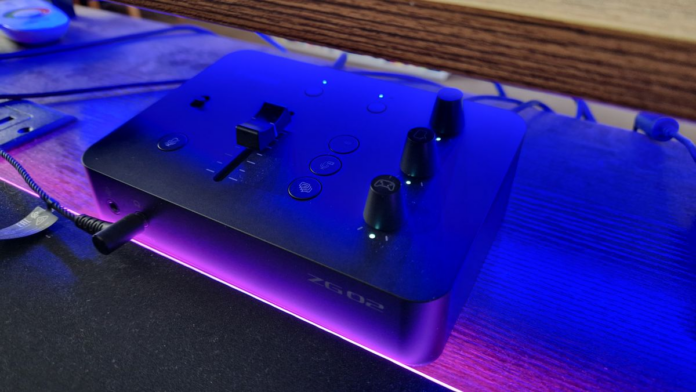The Yamaha ZG02 does the basics well, but its design choices prevent it from doing much more than that. It works brilliantly for streamers playing on a PS5 since a simple USB-C connection makes it easy to route through all your audio. Annoyingly, the lack of a fourth volume knob in lieu of some silly effects buttons means most creators are going to be found wanting if they want background music in their mix. That and software foibles really hamstrung this device for me.
Why you can trust GamesRadar+ Our experts review games, movies and tech over countless hours, so you can choose the best for you. Find out more about our reviews policy.
The Yamaha ZG02 streaming mixer might surprise you. For starters, who would expect Yamaha to make products for gamers? A piece of streaming hardware might not immediately gel with a lineup of motorcycles, scooters, keyboards, and guitars, but then again, who are we to judge? Not only is the ZG02 made for gaming content creators, but as its name suggests, it’s actually the brand’s second attempt at entering the streaming market.
Streaming gear for gamers feels like an inexact science, even for well-known brands in the space. As someone who reviews that technology for a living, I can safely say that this subset of hardware feels like a solution to something that just wasn’t meant to work. That’s true enough for the established companies that design this hardware, so when a brand that’s had little to no experience tries to make magic happen, it seldom goes well.
Luckily, the folks at Yamaha Music have decades of experience in the audio department, and their first mixer, the ZG01, seems like it was a promising start. The ZG02 is certainly a strong baseline for content creators looking to take more control of their audio, but I’m afraid to say it’s not much more than that. At an MSRP of $199.95 in the US, and available for £170-180 in the UK, it comes up short against the big names in the best streaming controller race.
Design
I’m sorry to say that the design of the Yamaha ZG02 is not an attractive one. In fact, there’s not a lot that immediately signals it’s a device geared at gamers or live streamers. Its chassis is a black box that’s as basic as can be. It’s plastic, it’s hollow, and its buttons almost echo through it when clicked in. It definitely doesn’t feel worth the MSRP, and that’s a real shame.
(Image credit: Future / Duncan Robertson)
I don’t think you need the RodeCaster Duo’s LED pads or the BEACN Mix Create’s swanky display, but something with a bit more flare would certainly be welcome on a device like this. Not least because streamers need to be able to glance down at it in a dark lighting scenario and know exactly which volume knob does what. I’ve tested this product for well over two weeks now, and I still have to squint at it to know which buttons are which, and where those buttons even are.
Sadly, the aesthetics aren’t the only thing that disappoints in the design department. On the ZG02’s face, you’ll find three volume knobs on its right-hand side. Then we have three buttons, two for audio effects and one to add echo. This is, by far, one of my biggest frustrations with what Yamaha has made. Four volume knobs simply must be the minimum on a mixer of this price. Mic, game, music, and voice chat are the go-to audio sources for gaming live streamers, and each one really needs its own fader.
The ones Yamaha has put in place are for your mic, voice chat, and game audio, so no matter which way you configure things, you’re going to need to double something up if you want background music in the mix. I just don’t get the design choice of putting effect buttons where more volume adjusters could be. I don’t know any gaming creator that would rather have their game audio distorted instead of having dedicated volume knobs for creator and broadcast mixes. Moreover, I don’t know of a streamer who’s so hell-bent on using vocal effects that they’d gladly forgo a dedicated way of fading out background music.
(Image credit: Future / Duncan Robertson)
The only fader you’ll get here is one for the XLR mic’s output level, but confusingly, there’s a switch to the left of it that controls its gain in three increments. The top volume knob controls how loud your microphone’s monitoring level is too, so it’s a bit confusing knowing which one to adjust mid-stream. There is a handy mute button since a lot of the best microphones for streaming and gaming in the XLR category miss those out. There’s also a phantom power 48V button and one for switching between the headphone and speaker outputs.
Connectivity is one of this mixer’s biggest strengths, however. The back IO has an XLR mic in port, a speaker out port, and two USB-C bays. One of these, which is clearly labeled, plugs into your gaming PC and powers the device. The other is an open port for a secondary USB-C connection. If you stream gameplay from a PS5, this will slot in here, but I’d imagine a second gaming PC could potentially work as well. On the front, you’ll find a 3.5mm headphone jack and a secondary jack for wired gaming headset mics – which is useful if you don’t have a bespoke XLR mic yet.
The unit itself isn’t particularly weighty, which means it very easily slides around a desk. If you struggle for space on your worktop, this does have a smaller footprint than its older sibling, the ZG01. In making this device smaller though, Yamaha has actually taken away some convenience instead of adding it. The larger ZG01 has a central volume knob, and a larger, more communicative facial panel overall.
Features
(Image credit: Future / Duncan Robertson)
Like any streaming mixer today, there is a bespoke bit of software you’ll need to download to reap the ZG02’s benefits. I will say now though, this software feels as frustratingly limited as the mixer’s design, and I’m not sure which irks me more.
The Yamaha ZG Controller app opens up to a home page that’s very stripped back. It only gives you some quick functions that are already on the mixer, as well as an overall output level that feels glaringly lacking from the console’s face.
After digging through tabs for controlling the microphone and game sound effects, you’ll find a very thin mixer menu. In most gaming-centric audio software, this is front and center and usually features a simple drag-and-drop system for mapping audio sources to volume knobs. Think SteelSeries Sonar or BEACN’s software, for reference.
That is so not what you find here. In fact, mapping audio sources to volume knobs is a very confusing process that’s done manually in each application you want to use in your live stream, not in the app at all. On the bright side, I love that this is an audio program that doesn’t dominate my CPU’s processing abilities. On the other hand, this makes it a nightmare to set up and means you’ll likely need to readjust your in-app settings between streams.
(Image credit: Future / Duncan Robertson)
It doesn’t help that the online manuals for this mixer are woefully unhelpful, and closely resemble the look and tone of a maths exam. As you’ll see above, the language used in these manuals is so tricky to understand that it seems like its purpose is to confuse you. At the time of writing, there’s a series of online video tutorials for the ZG01 mixer, but these aren’t much clearer. If I spent close to $200 on this thing, I wouldn’t want to work out how to use it from video tutorials dedicated to another device.
The one saving grace of the streaming mixer tab is its linking buttons that distinguish what you hear from what your audience will hear. These can be indicated by small




